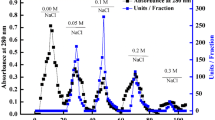Abstract
Superoxide dismutase (SOD, EC 1.15.1.1) plays an important role in pharmaceutical, neutraceutical and cosmeceutical industries as it can eliminate toxic superoxide radicals. Copper and zinc SOD was purified from pumpkin (Cucurbita moschata) stringy pulp. The stepwise procedure consisted phosphate extraction, heat treatment, ammonium sulfate precipitation, Sephadex G-100 gel filtration and DEAE-52 chromatography. This procedure resulted in a single band on native polyacrylamide gels and sodium dodecyl sulfate–polyacrylamide gels. The enzyme was purified 54.4-fold with its specific activity of 1,794 U/mg protein and the yield of 23.1 %. The enzyme molecular mass was estimated at 35.3 ± 0.6 kDa by gel filtration. The subunit molecular mass of this homo-dimeric protein was estimated at 17.5 ± 0.3 kDa on sodium dodecyl sulfate–polyacrylamide gels. The purified enzyme, which was characterized as a H2O2-sensitive SOD, contained approximately one copper atom and one zinc atom per subunit, indicating that it belongs to the Cu,Zn-SOD. The enzyme was found to remain thermostable lower than 50 °C. Pumpkin pulp Cu,Zn-SOD appeared to remain wider range of pH stability than other plant Cu,Zn-SOD, as it showed a strong and steady activity at a wider range of pH from 4 to 12 at 25 °C for 2 h. The enzyme was slightly inhibited by SDS and NaN3, but was not inhibited by Na3BO3 and sodium citrate. Therefore, these results suggested that pumpkin stringy pulp which is considered as a waste can be used as a rich source of Cu,Zn-SOD and can be commercially exploited in cosmeceuticals, pharmaceuticals and neutraceuticals.







Similar content being viewed by others
References
Paris HS, Brown RN (2005) The genes of pumpkin and squash. HortScience 40:1620–1630
Fu C, Shi H, Li Q (2006) A review on pharmacological activities and utilization technologies of pumpkin. Plant Foods Hum Nutr 61:73–80
Shi J, Yi C, Ye X, Xue S, Jiang Y, Ma Y, Liu D (2010) Effects of supercritical CO2 fluid parameters on chemical composition and yield of carotenoids extracted from pumpkin. LWT-Food Sci Technol 43:39–44
Xanthopoulou MN, Nomikos T, Fragopoulou E, Antonopoulou S (2009) Antioxidant and lipoxygenase inhibitory activities of pumpkin seed extracts. Food Res Int 42:641–646
Parker MW, Blake CC (1988) Iron- and manganese-containing superoxide dismutases can be distinguished by analysis of their primary structures. FEBS Lett 229:377–382
Valdivia A, Pérez-Álvarez S, Aroca-Aguilar JD, Ikuta I, Jordán J (2009) Superoxide dismutases: a physiopharmacological update. J Physiol Biochem 65:195–208
Moreira PI, Siedlak SL, Aliev G, Zhu X, Cash AD, Smith MA, Perry G (2005) Oxidative stress mechanisms and potential therapeutics in Alzheimer disease. J Neural Transm 112:921–932
Lubrano V, Di Cecco P, Zucchelli GC (2006) Role of superoxide dismutase in vascular inflammation and in coronary artery disease. Clin Exp Med 6:84–88
He N, Li Q, Sun D, Ling X (2008) Isolation, purification and characterization of superoxide dismutase from garlic. Biochem Eng J 38:33–38
Beauchamp C, Fridovich I (1971) Superoxide dismutase: improved assays and an assay applicable to acrylamide gels. Anal Biochem 44:276–287
Bradford MM (1976) A rapid and sensitive method for the quantitation of microgram quantities of protein utilizing the principle of protein-dye binding. Anal Biochem 72:248–254
Laemmli UK (1970) Cleavage of structural proteins during the assembly of the head of Bacteriophage T4. Nature 227:680–685
Wang Z, He Z, Li S, Yuan Q (2005) Purification and partial characterization of Cu, Zn containing superoxide dismutase from entomogenous fungal species Cordyceps militaris. Enzyme Microb Technol 36:862–869
Kochhar S, Kochhar VK (2008) Identification and characterization of a super-stable Cu–Zn SOD from leaves of turmeric (Curcuma longa L.). Planta 228:307–318
Haddad NIA, Yuan Q (2005) Purification and some properties of Cu, Zn superoxide dismutase from Radix lethospermi seed, kind of Chinese traditional medicine. J Chromatogr B 818:123–131
Ragusa S, Cambria MT, Scarpa M, Di Paolo ML, Falconi M, Rigo A, Cambria A (2001) Properties of purified cytosolic isoenzyme I of Cu, Zn-superoxide dismutase from Nicotiana plumbaginifolia leaves. Protein Expr Purif 23:261–269
Babitha MP, Prakash HS, Shekar shetty H (2002) Purification and partial characterization of manganese superoxide dismutase from downy mildew resistant pearl millet seedlings. Plant Sci 163:917–924
Vyas D, Kumar S (2005) Purification and partial characterization of a low temperature responsive Mn-SOD from tea (Camellia sinensis (L.) O. Kuntze). Biochem Biophys Res Commun 329:831–838
Ahmed H, Schott EJ, Gauthier JD, Vasta GR (2003) Superoxide dismutases from the oyster parasite Perkinsus marinus: purification, biochemical characterization, and development of a plate microassay for activity. Anal Biochem 318:132–141
Colla G, Rouphael Y, Cardarelli M, Salerno A, Rea A (2010) The effectiveness of grafting to improve alkalinity tolerance in watermelon. Environ Exp Bot 68:283–291
Skarpanska-Stejnborn A, Pilaczynska-Szczesniak L, Basta P, Deskur-Smielecka E, Woitas-Slubowska D, Adach Z (2011) Effects of oral supplementation with plant superoxide dismutase extract on selected redox parameters and an inflammatory marker in a 2,000-m rowing-ergometer test. Int J Sport Nutr Exerc Metabol 21:124–134
Acknowledgments
This work was supported by the open fund of Research Center of Green Manufacturing and Energy-Saving and Emission Reduction Technology in Wuhan University of Science and Technology (B1207).
Conflict of interest
Xiaorong Qin, Mingjin Zhang and Lin Wu declare that we have no conflict of interest.
Author information
Authors and Affiliations
Corresponding author
Rights and permissions
About this article
Cite this article
Qin, X., Zhang, M. & Wu, L. Purification and characterization of Cu,Zn superoxide dismutase from pumpkin (Cucurbita moschata) pulp. Eur Food Res Technol 235, 1049–1054 (2012). https://doi.org/10.1007/s00217-012-1829-1
Received:
Revised:
Accepted:
Published:
Issue Date:
DOI: https://doi.org/10.1007/s00217-012-1829-1




